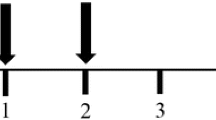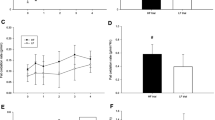Abstract
We examined the effect of exercise on postprandial lipemia (PPL) and insulin resistance in individuals with metabolic syndrome. Subjects were 10 hypertriglyceridemia (HTG) males with insulin resistance [age = 40.1 ± 2.2 years, body weight = 96.3 ± 3.3 kg, fasting triglyceride (TG) = 263 ± 25 mg/dl, VO2max = 37 ± 1.1 ml/kg/min, and Homeostatic Model Assessment (HOMA-IR, an index of insulin resistance) = 3.05 ± 0.40]. Each subject performed a control trial (Ctr, no exercise), and three exercise trials at 40% (40%T), 60% (60%T), and 70% (70%T) of their VO2max. The order of trials was randomized and there were 1–2 weeks wash-out period between the trials. All subjects had a fat-meal in each trial. In the exercise trials, subjects jogged on a treadmill for 1 h at a designated intensity 12 h prior to a fat-meal ingestion. Blood samples were taken at 0 h (before the meal), and 2, 4, 6, and 8 h after the meal. The plasma TG, area score under TG concentration curve for over an 8 h-period (TG AUC) after the meal, and HOMA-IR were analyzed. The TG AUC score in 40%T was 30% lower (P = 0.003), 60%T was 31% lower (P = 0.02), and 70%T was 39% lower (P = 0.02) than Ctr. There were no significant differences in the TG AUC scores among the exercise trials (P > 0.05). The insulin concentrations in both 60 and 70%T were lower than Ctr (P < 0.01) which did not differ from 40%T. HOMA-IR in both 60%T (P = 0.041) and 70%T (P = 0.002) were lower than Ctr, but not different from 40%T (HOMA-IR: Ctr = 3.05 ± 0.40, 40%T = 2.67 ± 0.35, 60%T = 2.49 ± 0.31, 70%T = 2.21 ± 0.27). The results suggest that for physically inactive individuals with metabolic syndrome, exercising at low to moderate intensity may be sufficient to attenuate PPL and increase insulin sensitivity, whereas higher intensity exercise may be needed to normalize blood glucose.




Similar content being viewed by others
References
ACSM (2000) ACSM’s guidelines for testing and prescription, 6th edn. Lippincott, Williams & Wilkins, Baltimore, vol 24, pp 63–66
Alberti KG, Zimmet PZ (1998) Definition, diagnosis and classification of diabetes mellitus and its complications. Part 1: diagnosis and classification of diabetes mellitus provisional report of a WHO consultation. Diabet Med 15:539–553
Altena TS, Michaelson JL, Ball SD, Thomas TR (2004) Single sessions of intermittent and continuous exercise and postprandial lipemia. Med Sci Sports Exerc 36:1364–1371
Borghouts LB, Backx K, Mensink MF, Keizer HA (1999) Effect of training intensity on insulin sensitivity as evaluated by insulin tolerance test. Eur J Appl Physiol Occup Physiol 80:461–466
Cummings MH, Watts GF, Umpleby AM, Hennessy TR, Naoumova R, Slavin BM, Thompson GR, Sonksen PH (1995) Increased hepatic secretion of very-low-density lipoprotein apolipoprotein B−100 in NIDDM. Diabetologia 38:959–967
Dyck DJ, Steinberg G, Bonen A (2001) Insulin increases FA uptake and esterification but reduces lipid utilization in isolated contracting muscle. Am J Physiol Endocrinol Metab 281:E600–E607
Gotto Jr A (1998) Triglyceride as a risk factor for coronary artery disease. Am J Cardiol 82:22Q–25Q
Hardin DS, Azzarelli B, Edwards J, Wigglesworth J, Maianu L, Brechtel G, Johnson A, Baron A, Garvey WT (1995) Mechanisms of enhanced insulin sensitivity in endurance-trained athletes: effects on blood flow and differential expression of GLUT 4 in skeletal muscles. J Clin Endocrinol Metab 80:2437–2446
Ivy JL, Frishberg BA, Farrell SW, Miller WJ, Sherman WM (1985) Effects of elevated and exercise-reduced muscle glycogen levels on insulin sensitivity. J Appl Physiol 59:154–159
Jeppesen J, Hollenbeck CB, Zhou MY, Coulston AM, Jones C, Chen YD, Reaven GM (1995) Relation between insulin resistance, hyperinsulinemia, postheparin plasma lipoprotein lipase activity, and postprandial lipemia. Arterioscler Thromb Vasc Biol 15:320–324
Karpe F (1999) Postprandial lipoprotein metabolism and atherosclerosis. J Internal Med 246:341–355
Katsanos CS, Grandjean PW, Moffatt RJ (2004) Effects of low and moderate exercise intensity on postprandial lipemia and postheparin plasma lipoprotein lipase activity in physically active men. J Appl Physiol 96:181–188
Kolovou GD, Anagnostopoulou KK, Cokkinos DV (2005) Pathophysiology of dyslipidaemia in the metabolic syndrome. Postgrad Med J 81:358–366
Lampman RM, Santinga JT, SavagePJ, Bassett DR, Hydrick CR, Flora JD Jr, Block WD (1985) Effect of exercise training on glucose tolerance, in vivo insulin sensitivity, lipid and lipoprotein concentrations in middle-aged men with mild hypertriglyceridemia. Metabolism 34:205–211
Laville M, Auboeuf D, Khalfallah Y, Vega N, Riou JP, Vidal H (1996) Acute regulation by insulin of phosphatidylinositol-3-kinase, Rad, Glut 4, and lipoprotein lipase mRNA levels in human muscle. J Clin Invest 98:43–49
Levy E, Zoltowska M (1999) Prolonged post-prandial increment in obese subjects with intra-abdominal visceral fat accumulation. Eur J Clin Invest 29:271–273
Levy JC, Matthews DR, Hermans MP (1998) Correct Homeostasis Model Assessment (HOMA-IR) Evaluation uses the computer program. Diabetes Care 21:2191–2192
Lewis GF, O’Meara NM, Soltys PA, Blackman JD, Iverius PH., Druetzler AF, Getz GS, Polonsky KS (1990) Postprandial lipoprotein metabolism in normal and obese subjects: comparison after the vitamin A fat-loading test. J Clin Endocrinol Metab 71:1041–1050
Looney MA, Feltz CJ, VanVleet CN (1994) The reporting and analysis of research findings for within-subject designs: methodological issues for meta-analysis. Res Q Exerc Sport 65:363–366
Lusk G (1928) The Atwater-Rosa respiration calorimeter. In: Lusk G (ed) The elements of the science of nutrition, 4th edn. WB Saunders Co, Philadelphia, pp 61–74
Mohn A, Marcovecchio M, Chiarelli F (2006) Validity of HOMA-IR as index of insulin resistance in obesity. J Pediatr 148(4):565–566
Patsch JR, Miesenbock G, Hopferwieser T, Muhlberger V, Knapp E, Dunn JK, Gotto AM Jr, Patsch (1992) Relation of triglyceride metabolism and coronary artery disease. Studies in the postprandial state. Arterioscler Thromb 12:1336–1345
Reitman JK, Baldwin M, Holloszy JO (1973) Intramuscular triglyceride utilization by red, white, and intermediate skeletal muscle and heart during exhausting exercise. Proc Soc Exp Biol Med 142:628–631
Riccardi G, Giacco R, Rivellese AA (2004) Dietary fat, insulin sensitivity and the metabolic syndrome. Clin Nutr 23:447–456
Taskinen MR, Nikkila EA (1981) Lipoprotein lipase of adipose tissue and skeletal muscle in human obesity: response to glucose and to semistarvation. Metab Clin Exp 30:810–817
Tsetsonis NV, Hardman AE (1996) Reduction in postprandial lipemia after walking: influence of exercise intensity. Med Sci Sports Exerc 28:1235–1242
Stevens J (2002) Applied multivariate statistics for social sciences, 4th edn. Lawrence Erlbaum Associates. Mahwah pp 510–511
Wallace TM, Levy JC, Matthews DR (2004) Use and Abuse of HOMA-IR modeling. Diabetes Care 27(6):1487–1495
Zammit VA, Waterman IJ, Topping D, McKay G (2001) Insulin stimulation of hepatic triacylglycerol secretion and the etiology of insulin resistance. J Nutr 131:2074–2047
Zhang JQ, Ji LL, Nunez G, Feathers S, Hart CL, Yao WY (2004) Effect of exercise timing on postprandial lipemia in hypertriglyceridemic men. Can J Appl Physiol 29:590–603
Zhang JQ, Smith B, Langdon MM, Messimer HL, Sun GY, Cox RH, James-Kracke M, Thomas TR (2002) Changes in LPLa and reverse cholesterol transport variables during 24-h postexercise period. Am J Physiol Endocrinol Metab 283:E267–E274
Zhang JQ, Thomas TR, Ball SD (1998) Effect of exercise timing on postprandial lipemia and HDL cholesterol subfractions. J Appl Physiol 85:1516–1522
Ziogas G, Thomas TR (1997) Exercise training, post-prandial lipemia, and LDL subfractions. Med Sci Sport Exerc 29:986–991
Acknowledgment
This work was supported by a grant from the American Heart Association, Texas Affiliate (grant #: 0150795Y).
Author information
Authors and Affiliations
Corresponding author
Rights and permissions
About this article
Cite this article
Zhang, J.Q., Ji, L.L., Fretwell, V.S. et al. Effect of exercise on postprandial lipemia in men with hypertriglyceridemia. Eur J Appl Physiol 98, 575–582 (2006). https://doi.org/10.1007/s00421-006-0304-8
Accepted:
Published:
Issue Date:
DOI: https://doi.org/10.1007/s00421-006-0304-8




